Sustainable Coastal Evolution and Critical Sediment Load Estimation in the Yellow River Delta
Abstract
1. Introduction
2. Study Area and Data Sources
2.1. Study Area
2.2. Remote Sensing Data
2.3. Runoff-Sediment Data
3. Methodology
3.1. Remote Sensing Water Index
3.2. Annual Frequency of Water
3.3. Extraction of Coastline
3.4. Evolution Analysis of Coast
3.4.1. Analysis of Coastline Changes
3.4.2. Assessment of Cumulative Land Area Change and the Runoff–Sediment Relationship
4. Results and Discussion
4.1. Dynamics of the Yellow River Delta Coastline
4.2. Evolution of Land Area Change in the Yellow River Delta
4.2.1. Evolution of the Overall Land Area Change in the Yellow River Delta
4.2.2. Evolution of Land Area Change in Typical Estuaries in the Yellow River Delta
4.3. Relationship Between Cumulative Land Area Change and Runoff-Sediment
4.4. Critical Sediment Load to Maintain Estuary Balance
5. Conclusions
Author Contributions
Funding
Institutional Review Board Statement
Informed Consent Statement
Data Availability Statement
Acknowledgments
Conflicts of Interest
References
- Zhang, K.; Dong, X.; Liu, Z.; Gao, W.; Hu, Z.; Wu, G. Mapping Tidal Flats with Landsat 8 Images and Google Earth Engine: A Case Study of the China’s Eastern Coastal Zone circa 2015. Remote Sens. 2019, 11, 924. [Google Scholar] [CrossRef]
- Cao, Y.; Wang, Q.; Zhan, C.; Li, R.; Qian, Z.; Wang, L.; Liu, X.; Zhu, J.; Shi, H.; Li, Y. Evolution of tidal flats in the Yellow River Qingshuigou sub-delta: Spatiotemporal analysis and mechanistic changes (1996–2021). Front. Mar. Sci. 2023, 10, 1286188. [Google Scholar] [CrossRef]
- Gao, W.; Du, J.; Gao, S.; Xu, Y.; Li, B.; Wei, X.; Zhang, Z.; Liu, J.; Li, P. Shoreline change due to global climate change and human activity at the Shandong Peninsula from 2007 to 2020. Front. Mar. Sci. 2023, 9, 1123067. [Google Scholar] [CrossRef]
- Zhang, L.; Shi, H.; Xing, H.; Li, P.; Ma, P. Analysis of the evolution of the Yellow River Delta coastline and the response of the tidal current field. Front. Mar. Sci. 2023, 10, 1232060. [Google Scholar] [CrossRef]
- Wang, K. Evolution of Yellow River Delta coastline based on remote sensing from 1976 to 2014, China. Chin. Geogr. Sci. 2019, 29, 181–191. [Google Scholar] [CrossRef]
- Zhu, Q.; Li, P.; Li, Z.; Pu, S.; Wu, X.; Bi, N.; Wang, H. Spatiotemporal Changes of Coastline over the Yellow River Delta in the Previous 40 Years with Optical and SAR Remote Sensing. Remote Sens. 2021, 13, 1940. [Google Scholar] [CrossRef]
- Kong, D.; Miao, C.; Zheng, H.; Gou, J. Dynamic evolution characteristics of the Yellow River Delta in response to estuary diversion and a water–sediment regulation scheme. J. Hydrol. 2023, 627, 130447. [Google Scholar] [CrossRef]
- Chen, Y.; Dong, J.; Xiao, X.; Ma, Z.; Tan, K.; Melville, D.; Li, B.; Lu, H.; Liu, J.; Liu, F. Effects of reclamation and natural changes on coastal wetlands bordering China’s Yellow Sea from 1984 to 2015. Land Degrad. Dev. 2019, 30, 1533–1544. [Google Scholar] [CrossRef]
- Zhou, X.; Wang, J.; Zheng, F.; Wang, H.; Yang, H. An overview of coastline extraction from remote sensing data. Remote Sens. 2023, 15, 4865. [Google Scholar] [CrossRef]
- Mao, Y.; Harris, D.; Xie, Z.; Phinn, S. Efficient measurement of large-scale decadal shoreline change with increased accuracy in tide-dominated coastal environments with Google Earth Engine. ISPRS J. Photogramm. Remote Sens. 2021, 181, 385–399. [Google Scholar] [CrossRef]
- Zhang, S.; Xu, Q.; Wang, H.; Kang, Y.; Li, X. Automatic Waterline Extraction and Topographic Mapping of Tidal Flats From SAR Images Based on Deep Learning. Geophys. Res. Lett. 2022, 49, e2021GL096007. [Google Scholar] [CrossRef]
- Li, C.; Zhu, L.; Dai, Z.; Wu, Z. Study on spatiotemporal evolution of the Yellow River Delta coastline from 1976 to 2020. Remote Sens. 2021, 13, 4789. [Google Scholar] [CrossRef]
- Wang, X.; Xiao, X.; Zou, Z.; Chen, B.; Ma, J.; Dong, J.; Doughty, R.B.; Zhong, Q.; Qin, Y.; Dai, S.; et al. Tracking annual changes of coastal tidal flats in China during 1986–2016 through analyses of Landsat images with Google Earth Engine. Remote Sens. Environ. 2018, 238, 110987. [Google Scholar] [CrossRef] [PubMed]
- Liu, X.; Gao, Z.; Ning, J.; Yu, X.; Zhang, Y. An improved method for mapping tidal flats based on remote sensing waterlines: A case study in the Bohai Rim, China. IEEE J. Sel. Top. Appl. Earth Obs. Remote Sens. 2016, 9, 5123–5129. [Google Scholar] [CrossRef]
- Fan, Y.; Chen, S.; Zhao, B.; Pan, S.; Jiang, C.; Ji, H. Shoreline dynamics of the active Yellow River delta since the implementation of Water-Sediment Regulation Scheme: A remote-sensing and statistics-based approach. Estuar. Coast. Shelf Sci. 2018, 200, 406–419. [Google Scholar] [CrossRef]
- Li, D.; Gao, W.; Shao, D.; Amenuvor, M.; Tong, Y.; Cui, B. A tale of two deltas: Dam-induced hydro-morphological evolution of the Volta River delta (Ghana) and Yellow River delta (China). Water 2021, 13, 3198. [Google Scholar] [CrossRef]
- Jia, W.; Yi, Y. Numerical study of the water-sediment regulation scheme (WSRS) impact on suspended sediment transport in the Yellow River Estuary. Front. Mar. Sci. 2023, 10, 1135118. [Google Scholar] [CrossRef]
- Wang, H.; Wu, X.; Bi, N.; Li, S.; Yuan, P.; Wang, A.; Syvitski, J.P.M.; Saito, Y.; Yang, Z.; Liu, S.; et al. Impacts of the dam-orientated water-sediment regulation scheme on the lower reaches and delta of the Yellow River (Huanghe): A review. Glob. Planet. Chang. 2017, 157, 93–113. [Google Scholar] [CrossRef]
- Tang, W.; Zhao, C.; Lin, J.; Jiao, C.; Zheng, G.; Zhu, J.; Pan, X.; Han, X. Improved Spectral Water Index Combined with Otsu Algorithm to Extract Muddy Coastline Data. Water 2022, 14, 855. [Google Scholar] [CrossRef]
- Jia, M.; Wang, Z.; Mao, D.; Ren, C.; Wang, C.; Wang, Y. Rapid, robust, and automated mapping of tidal flats in China using time series Sentinel-2 images and Google Earth Engine. Remote Sens. Environ. 2021, 255, 112285. [Google Scholar] [CrossRef]
- Zou, Z.; Dong, J.; Menarguez, M.A.; Xiao, X.; Qin, Y.; Doughty, R.B.; Hooker, K.V.; David Hambright, K. Continued decrease of open surface water body area in Oklahoma during 1984–2015. Sci. Total Environ. 2017, 595, 451–460. [Google Scholar] [CrossRef]
- Wang, X.; Xiao, X.; Zou, Z.; Hou, L.; Qin, Y.; Dong, J.; Doughty, R.B.; Chen, B.; Zhang, X.; Chen, Y.; et al. Mapping coastal wetlands of China using time series Landsat images in 2018 and Google Earth Engine. ISPRS J. Photogramm. Remote Sens. 2020, 163, 312–326. [Google Scholar] [CrossRef]
- Macqueen, J.B. Some methods for classification and analysis of multivariate observations. In Proceedings of the Fifth Berkeley Symposium on Mathematical Statistics and Probability, Berkeley, CA, USA, 27 December 1965–7 January 1966. [Google Scholar]
- Figliomeni, F.G.; Guastaferro, F.; Parente, C.; Vallario, A. A proposal for automatic coastline extraction from Landsat 8 OLI images combining modified optimum index factor (MOIF) and K-Means. Remote Sens. 2023, 15, 3181. [Google Scholar] [CrossRef]
- Zhu, Y.; Li, Z.; Zhao, Z.; Lu, L.; Yang, S.; Wang, Z. Spatio-temporal changes of coastline in Jiaozhou Bay from 1987 to 2022 based on optical and SAR data. Front. Mar. Sci. 2023, 10, 1233410. [Google Scholar] [CrossRef]
- Anfuso, G.; Bowman, D.; Danese, C.; Pranzini, E. Transect based analysis versus area based analysis to quantify shoreline displacement: Spatial resolution issues. Environ. Monit. Assess. 2016, 188, 568. [Google Scholar] [CrossRef]
- Liu, Y.; Du, T.; Huang, H.; Liu, Y.; Zhang, Y. Estimation of sediment compaction and its relationship with river channel distributions in the Yellow River delta, China. Catena 2019, 182, 104113. [Google Scholar] [CrossRef]
- Li, H.; Huang, C.; Liu, Q.; Liu, G. Accretion–Erosion Dynamics of the Yellow River Delta and the Relationships with Runoff and Sediment from 1976 to 2018. Water 2020, 12, 2992. [Google Scholar] [CrossRef]
- Bi, N.; Wang, H.; Yang, Z. Recent changes in the erosion–accretion patterns of the active Huanghe (Yellow River) delta lobe caused by human activities. Cont. Shelf Res. 2014, 90, 70–78. [Google Scholar] [CrossRef]
- Li, P.; Ke, Y.; Wang, D.; Ji, H.; Chen, S.; Chen, M.; Lyu, M.; Zhou, D. Human impact on suspended particulate matter in the Yellow River Estuary, China: Evidence from remote sensing data fusion using an improved spatiotemporal fusion method. Sci. Total Environ. 2021, 750, 141612. [Google Scholar] [CrossRef]
- Yi, Y.; Wang, X.; Liu, Q.; Zhang, J.; Yi, Q. Influence of Water–Sediment Regulation Scheme on Accretion and Erosion in a River Delta: A Case Study of the Yellow River Delta, China. Estuaries Coasts 2022, 45, 1879–1887. [Google Scholar] [CrossRef]
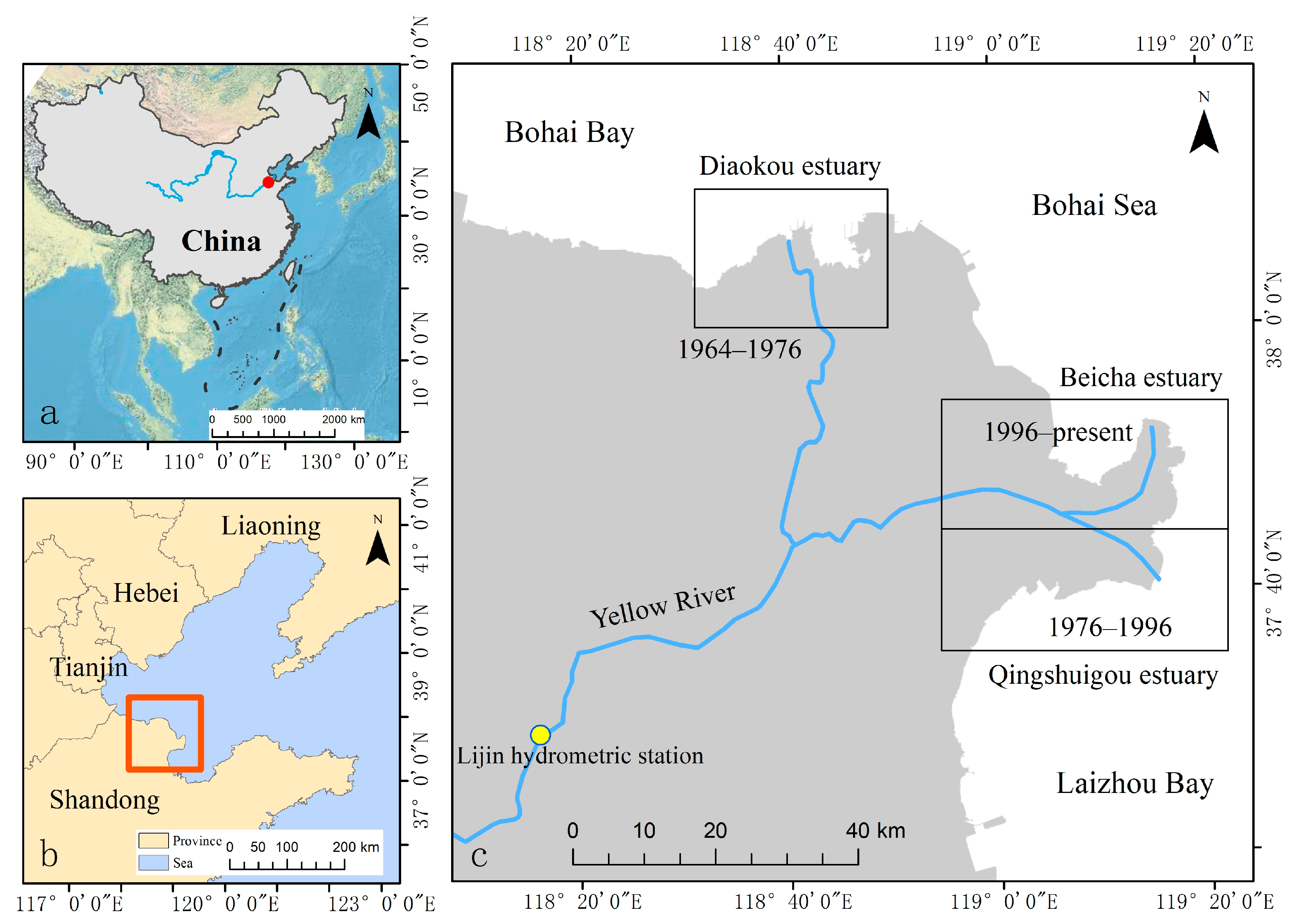
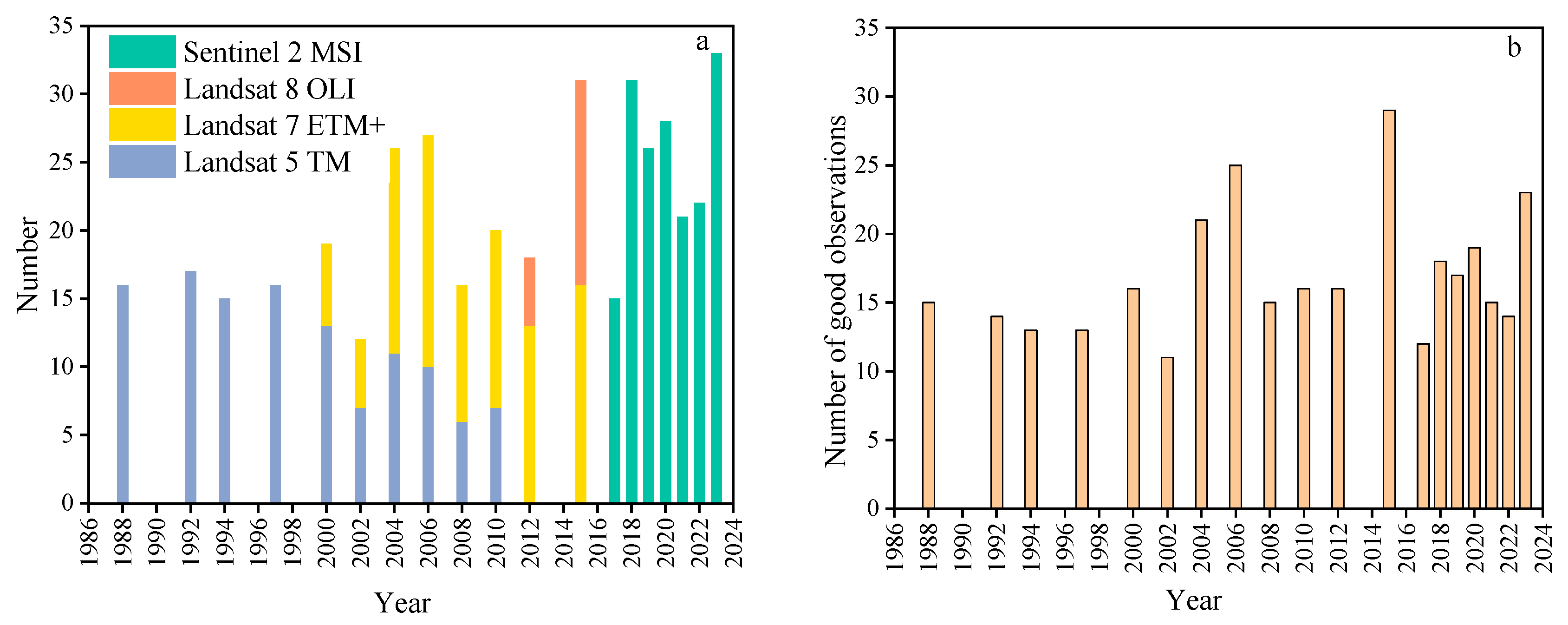

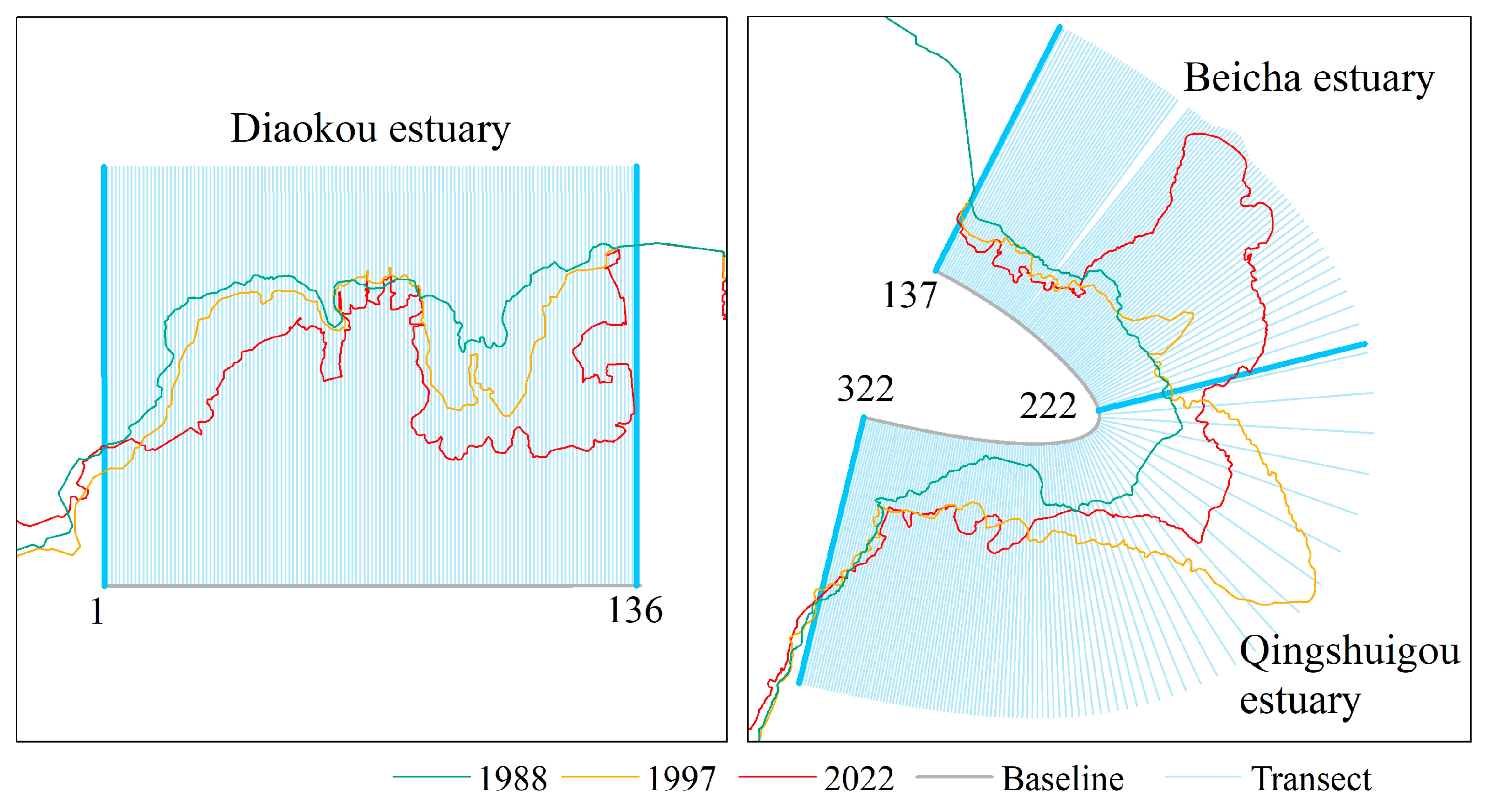
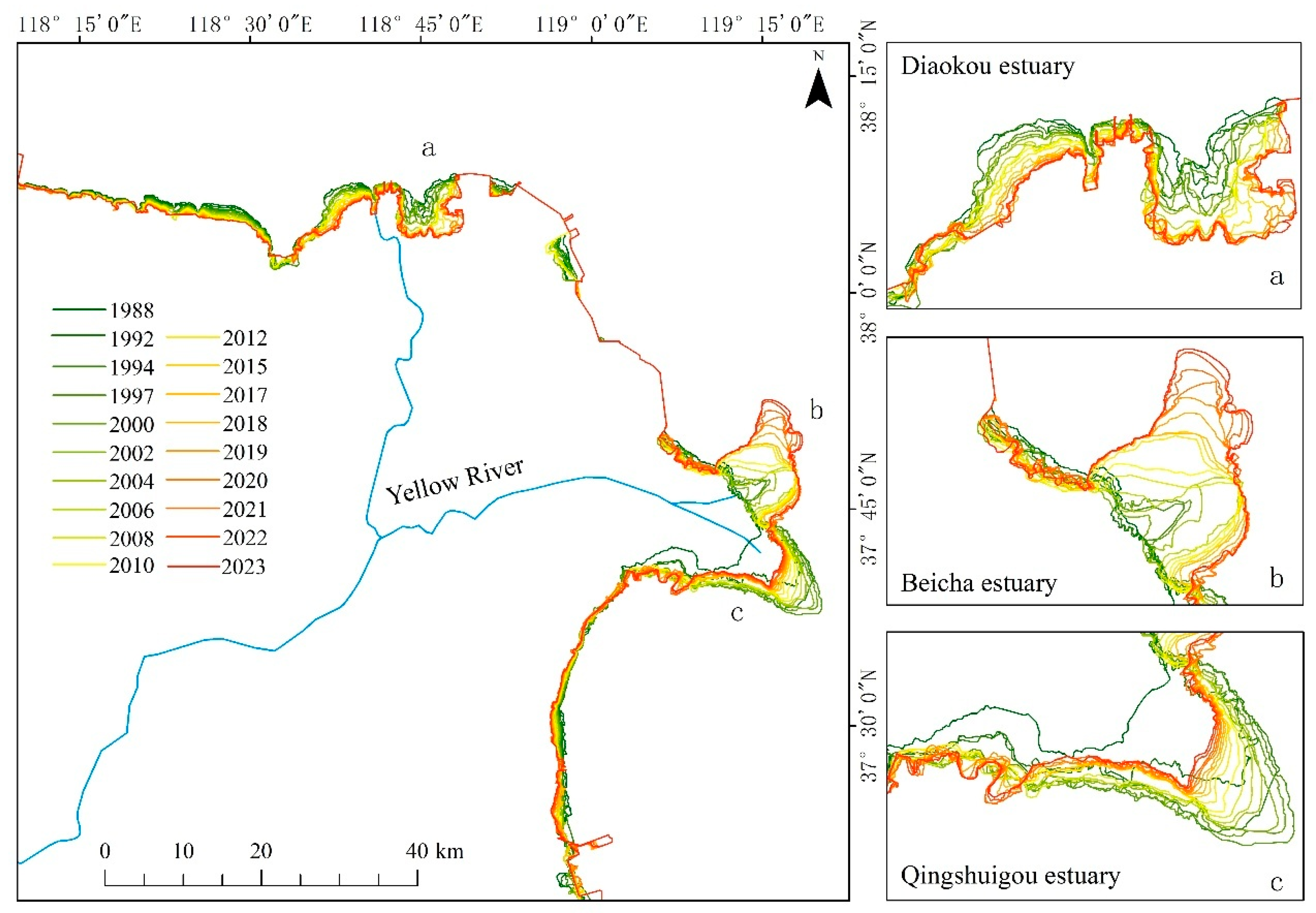
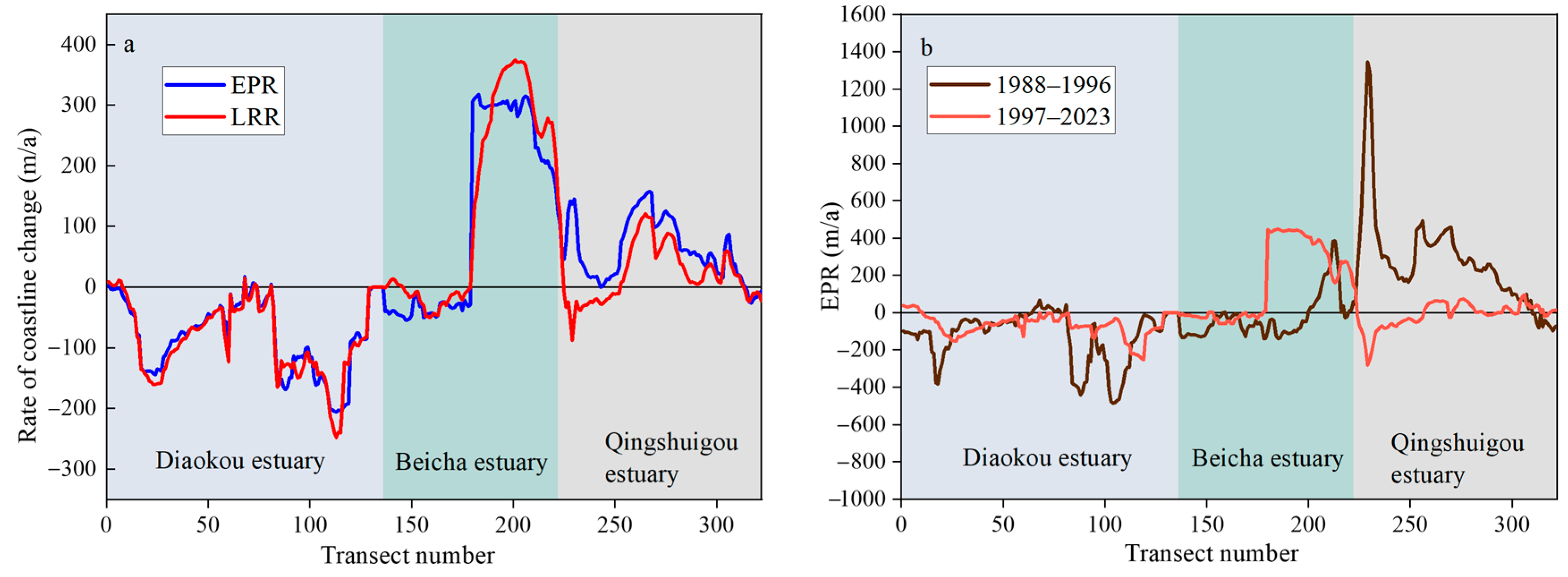
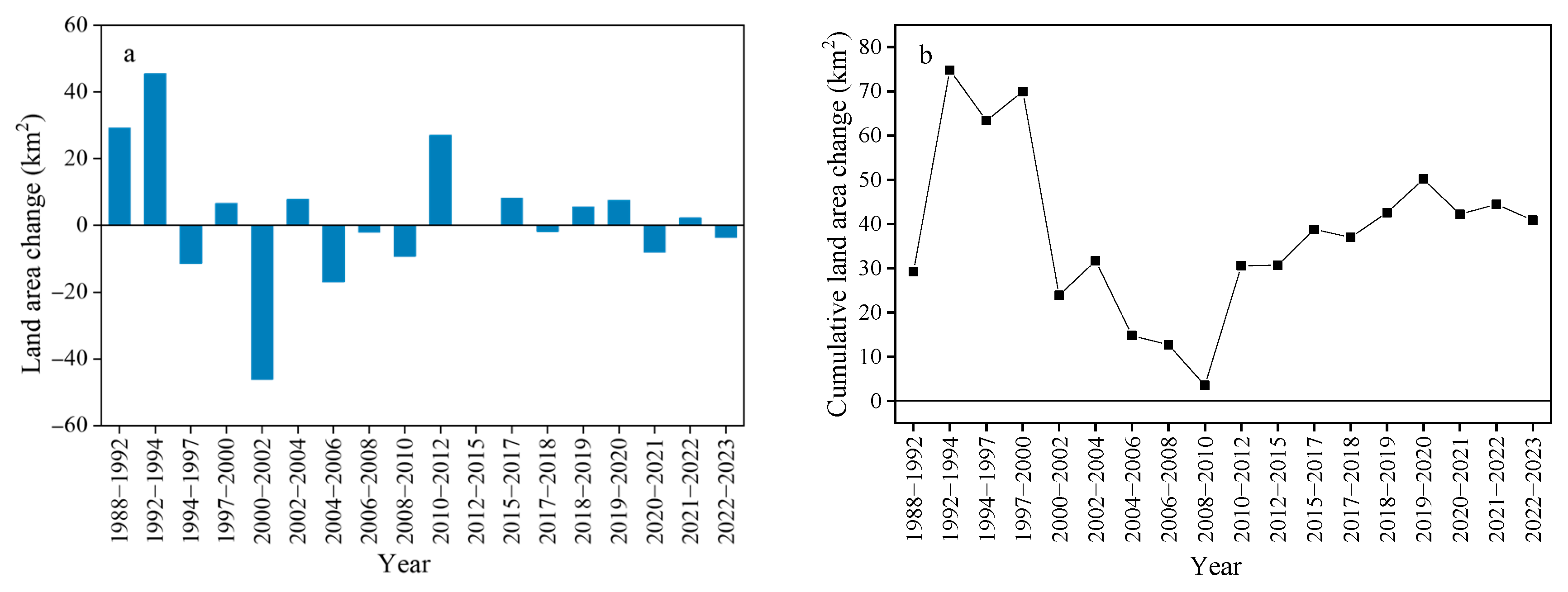

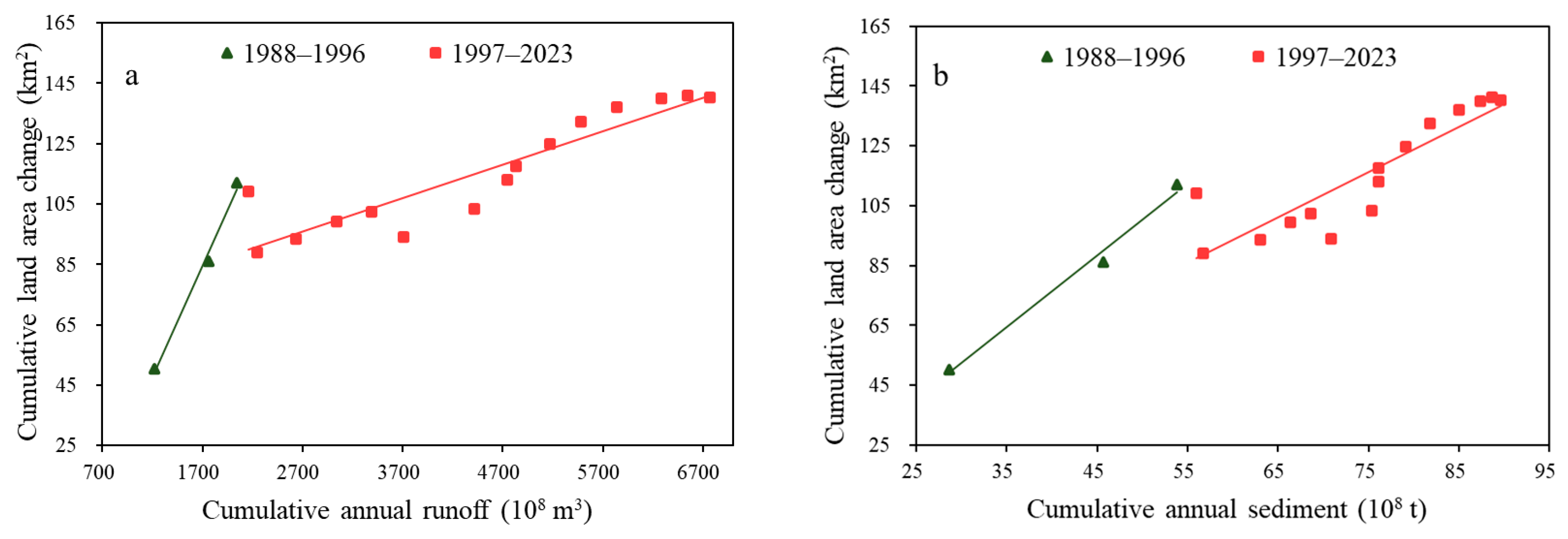


| Area | Transect Numbers | Average EPR (m/a) | Average LRR (m/a) | Maximum EPR (m/a) | Maximum LRR (m/a) | Minimum EPR (m/a) | Minimum EPR (m/a) | Average EPR (m/a) | Average LRR (m/a) |
|---|---|---|---|---|---|---|---|---|---|
| Diaokou estuary | 1–136 | −81.54 | −84.50 | 17.39 | 14.98 | −206.05 | −248.33 | 16.11 | 7.38 |
| Beicha estuary | 137–222 | 117.59 | 135.84 | 317.54 | 374.14 | −54.13 | −50.58 | ||
| Qingshuigou estuary | 223–322 | 61.65 | 21.85 | 157.54 | 120.84 | −26.41 | −87.84 |
| Time Period | Area | Transect Numbers | Average EPR (m/a) | Maximum EPR (m/a) | Minimum EPR (m/a) | Average EPR (m/a) |
|---|---|---|---|---|---|---|
| 1988–1996 | Diaokou estuary | 1–136 | −124.44 | 67.63 | −486.23 | 24.06 |
| Beicha estuary | 137–222 | −25.80 | 385.46 | −139.61 | ||
| Qingshuigou estuary | 223–322 | 268.89 | 1345.91 | −97.36 | ||
| 1997–2023 | Diaokou estuary | 1–136 | −66.69 | 38.02 | −253.61 | 13.36 |
| Beicha estuary | 137–222 | 167.22 | 448.52 | −59.67 | ||
| Qingshuigou estuary | 223–322 | −10.09 | 124.65 | −281.64 |
Disclaimer/Publisher’s Note: The statements, opinions and data contained in all publications are solely those of the individual author(s) and contributor(s) and not of MDPI and/or the editor(s). MDPI and/or the editor(s) disclaim responsibility for any injury to people or property resulting from any ideas, methods, instructions or products referred to in the content. |
© 2025 by the authors. Licensee MDPI, Basel, Switzerland. This article is an open access article distributed under the terms and conditions of the Creative Commons Attribution (CC BY) license (https://creativecommons.org/licenses/by/4.0/).
Share and Cite
Rong, L.; Zhou, Y.; Li, H.; Huang, C. Sustainable Coastal Evolution and Critical Sediment Load Estimation in the Yellow River Delta. Sustainability 2025, 17, 5943. https://doi.org/10.3390/su17135943
Rong L, Zhou Y, Li H, Huang C. Sustainable Coastal Evolution and Critical Sediment Load Estimation in the Yellow River Delta. Sustainability. 2025; 17(13):5943. https://doi.org/10.3390/su17135943
Chicago/Turabian StyleRong, Lishan, Yanyi Zhou, He Li, and Chong Huang. 2025. "Sustainable Coastal Evolution and Critical Sediment Load Estimation in the Yellow River Delta" Sustainability 17, no. 13: 5943. https://doi.org/10.3390/su17135943
APA StyleRong, L., Zhou, Y., Li, H., & Huang, C. (2025). Sustainable Coastal Evolution and Critical Sediment Load Estimation in the Yellow River Delta. Sustainability, 17(13), 5943. https://doi.org/10.3390/su17135943







